How To: Regulate Your Home’s Humidity Level
May 2nd, 2023 | 10 min. read
Get weekly updates with the most recent articles and videos from Southwest Exteriors.
Subscribe
When most think about humidity, it has a negative connotation attached.
Humidity is uncomfortable. Humidity is muggy. Humidity makes you feel sticky.
With all these pessimistic undertones to humidity, the last thing you may think when it comes to regulating humidity in your home is, “Why would I want to make my home more humid?”
Moisture is a natural occurrence in the air. Plants, animals, and humans need it to survive without shriveling up and dying.
Too much moisture can be uncomfortable. Not having enough humidity can also be miserable to reside in.
So, what is a good humidity level for your home, and how can you ensure your humidity level is proper?
As a home remodeling contractor since 1989, Southwest Exteriors stands to educate homeowners on all things home solutions.
Whether it’s replacing your home’s windows, redesigning a new pantry, or regulating your home’s humidity, we’re here to answer all your questions about improving the functionality of your home.
This article will cover how you can monitor your home’s humidity levels and what to do when humidity levels are too high or low.
How Can I Monitor My Home’s Humidity Levels?
If you’ve never thought about the humidity in your home, one of the first things you need to know is how you can measure and monitor moisture levels in your home.
Humidity levels are measured in percentages.
| The ideal humidity level for a home can range between 30-50%, depending on the | season and your comfort level.
So, how can you measure the humidity level in your home?
The easiest way to monitor humidity levels in your home is by investing in a thermostat with the ability to measure moisture.
Smart thermostats have become increasingly popular in the age of technology we live in. They can range anywhere from around $25 for a small, portable thermostat to upwards of $300 for a fully functioning smart thermostat.
Choosing the right thermostat for your home depends on your goals for upgrading your home’s technology and efficiency.
- If you want to start monitoring the humidity levels in your home, finding a portable thermostat that only measures temperature and humidity will do the trick.
- If you have wanted to upgrade your home’s thermostat and improve the overall efficiency of your home, then invest in a higher-quality smart thermostat that allows you to measure humidity, set schedules for your HVAC system, and provide reminders for important tune-ups on your system.
Check out some of these highly-rated simple thermostats on Amazon.
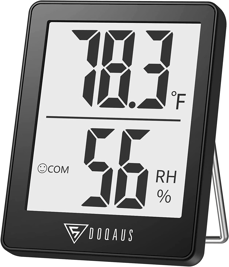
DOQAUS Digital Hygrometer Indoor Thermometer, $7.99, 4.4 Stars (9,653 Reviews)
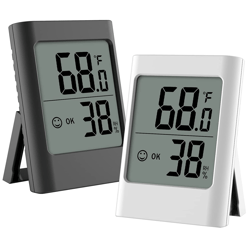
Humidity Gauge, 2 Pack Indoor Thermometer for Home, $10.00, 4.5 Stars (1,253 Reviews)
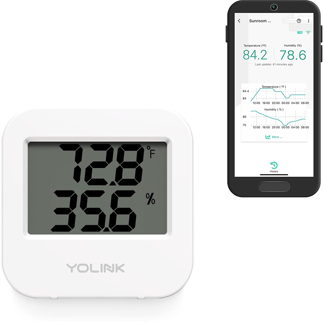
YoLink Smart Wireless Temperature & Humidity Sensor, $24.99, 4.6 Stars (1,058 Reviews)
Find the right smart thermostat for you from Amazon, Best Buy, or Walmart.
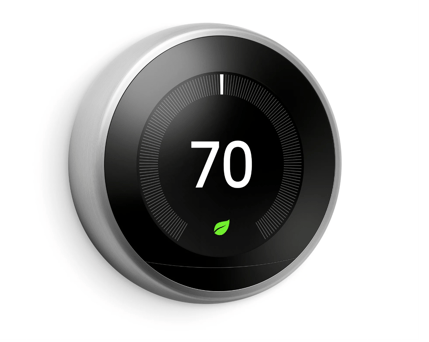
Nest Smart Learning Thermostat - 3rd Generation, $199, 4.9 Stars (19,619 Reviews)
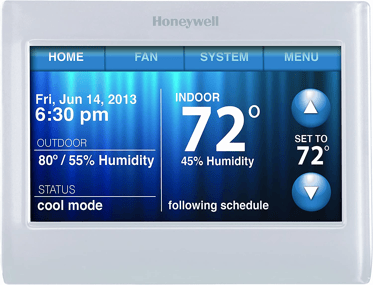
Honeywell Wireless WiFi Thermostat, $167.21, 4.4 Stars (5,115 Reviews)
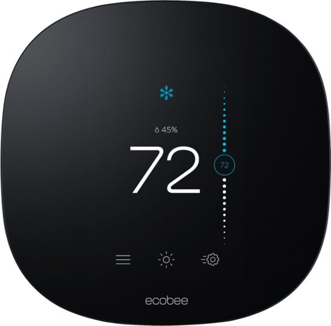
ecobee - 3 lite Smart Thermostat, $149.99, 4.7 Stars (1,894 Reviews)
How To Fix High Humidity In Your Home
Once you’ve got the right device to measure moisture levels in your home, you can take the next step to regulate the humidity, whether it’s too high or too low.
Even if you don’t have a smart thermostat yet, chances are you can feel it when there’s too much humidity in your home. It’s muggy, sticky, and makes you feel uncomfortable.
High humidity in homes is most common during warmer months of the year, especially after rain storms where moisture content is high outdoors.
Here are three simple ways to decrease humidity in your home.
1. Run the AC fan regularly throughout the day
If your home feels sticky and humid, running the fan in your HVAC unit will help keep air moving and expel some of that moisture in the air.
With a smart thermostat, try scheduling your fan to run for about five minutes every hour. This will help circulate air in your home, and you won’t even have to think about it.
For regular thermostats, set a timer to remind yourself to turn the fan on for five to ten minutes every hour or two. It’s more work on your part, but it will ensure your home is more comfortable.
2. Keep ceiling and floor fans on
Running your ceiling fans or any extra fans regularly will help circulate the air even more, on top of running your AC fan.
It’s the same idea as keeping the AC fan running. Your air will circulate more often and won’t make the air feel so still.
3. Use a dehumidifier
Want to take regulating humidity to another level? Invest in a dehumidifier for your home.
Dehumidifiers work through refrigeration. Basically, the dehumidifier takes in air from your home and rids it of water molecules through cooling coils.
You can find small dehumidifiers for around $50 or shop for a more high-end appliance for around $150 and upwards.
Shop for dehumidifiers on Amazon.
How To Fix Low Humidity In Your Home
Now you know how to regulate high humidity levels, what about low humidity?
If your home feels extremely dry, it can affect your skin, breathing, furniture, and overall comfort. You most likely feel lower humidity levels during colder months.
Here are three easy ways to fix low humidity in your home.
1. Use a humidifier
The first and most obvious way to increase humidity is to use a humidifier. Simply filling this machine with water creates a comfortable steam and emits moisture into the air.
Adding moisture to the air through a humidifier will help restore dry skin and furniture. Humidifiers are also convenient for getting direct moisture to your face or hands.
Some humidifiers can also diffuse essential oils to add moisture and a pleasant scent to your home simultaneously.
Shop for the right humidifier on Amazon.
2. Lower heating unit
When air is dry, adding heat makes it dryer. Compare it to blow-drying your hair with a hot tool. Once your hair is dry, the more you add heat to it, the drier it gets.
While it may be tempting to crank the heat up during especially cold months, lowering your heating unit will help retain moisture in the air and also help lower your energy bills.
3. Let the steam from hot showers and boiling water carry throughout your home
Two simple DIY methods to add humidity to your home is by letting the steam from your daily activities, like showering, cooking, and boiling water, escape throughout your home.
Using boiling or hot water that emulates steam is like making your own humidifier. You can add moisture to the air without really doing anything or investing in anything extra.
Want something even easier to add some moisture to your home? Set bowls of water in different rooms to let the water evaporate and turn into water molecules in the air.
Regulating And Maintaining Humidity Levels In Your Home
Now that you know the best tools to measure humidity in your home and what to do when humidity is too high or low, you have the right information to make your home more comfortable for you, your family, and your pets.
Regulating humidity in your home is beneficial for improving your home’s air quality and comfort level. This will help you breathe better and overall feel more comfortable.
- If your home is too humid, run your AC fan for five minutes hourly, keep ceiling fans running, and invest in a dehumidifier.
- If your home feels dry and doesn’t have enough moisture, use a humidifier, lower your heating system, and create natural steam from hot showers and boiling water.
Overall, if you want to measure and improve the humidity of your home, finding a thermostat that measures humidity levels will be your best friend. Then, you will know when the humidity is too high or low in your home and can take the right steps to remedy it.
If you notice drastic changes in humidity levels in your home throughout the year, the problem may be larger than just the weather. Your windows and doors could also be letting outside moisture and air get into your home and affect the air quality.
While Southwest Exteriors offers high-quality window and door replacements, we want to educate you on when a replacement may be necessary and what signs to look for.
Old or worn-out windows and doors can result in drafts, water infiltration, rotting, and overall temperature and comfort of your home. So, when is it time to replace your windows?
Check out this article that outlines three key signs it’s time to replace your windows and how to inspect them. If you notice any of these signs, replacing your windows can help regulate humidity levels in your home and help make it more comfortable and energy-efficient.